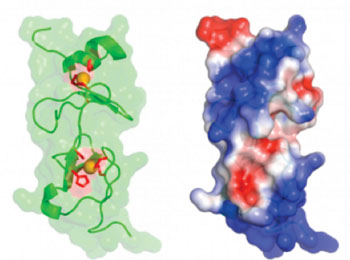Metastasis Drug Target Identified
By LabMedica International staff writers
Posted on 26 Mar 2014
Cancer researchers have identified a protein that is critically linked to processes leading to metastasis, the deadly spread of cancer away from the primary tumor.Posted on 26 Mar 2014
Investigators at The Wistar Institute (Philadelphia, PA, USA) examined the role of "LIM domain" proteins in metastasis. LIM domains are protein structural domains, composed of two contiguous zinc finger domains, separated by a two-amino acid residue hydrophobic linker. LIM domain containing proteins have been shown to play roles in cytoskeletal organization, organ development, and oncogenesis. LIM domains mediate protein-to-protein interactions that are critical to cellular processes.

Image: LIMD2, a protein that can drive metastasis (Photo courtesy of the Wistar Institute).
The investigators focused their attention on LIMD2, a mechanistically undefined LIM-only protein originally found to be overexpressed in metastatic lesions but absent in the matched primary tumor.
They determined the solution structure of LIMD2 using nuclear magnetic resonance and reported in the March 2014 issue of the journal Cancer Research that it revealed a classic LIM-domain structure that was highly related to LIM1 of PINCH1, a core component of the integrin-linked kinase-parvin-pinch complex. Structural and biochemical analyses revealed that LIMD2 bound directly to the kinase domain of integrin-linked kinase (ILK) near the active site and strongly activated ILK kinase activity. Cells that lacked ILK failed to respond to the induction of invasion by LIMD2.
LIMD2 levels in fresh and archival tumors positively correlated with cell motility, metastatic potential, and grade, including bladder, melanoma, breast, and thyroid tumors. LIMD2 directly contributed to these cellular phenotypes as shown by overexpression, knockdown, and reconstitution experiments in cell culture models.
“This is the result of a five year effort to characterize LIMD2, which is a new protein that we found to be expressed only in metastatic lesions, and not in the primary tumor or in normal tissues or organs,” said senior author Dr. Frank Rauscher III, a professor in the tumor microenvironment and metastasis program at The Wistar Institute. “LIMD2 is a great candidate for targeting with a drug, which would inhibit the ability of these cells to leave a primary tumor and to colonize other organs. We contend that LIMD2 is a marker that could help physicians profile tumors, and a potential drug target that could yield a potent therapy for a variety of advanced cancers, perhaps in combination with existing or emerging therapies.”
“Cancer metastasis is really the final frontier in cancer medicine, because metastasis kills,” said Dr. Rauscher. “We can treat a primary tumor, usually successfully, with surgery, drugs, chemotherapy, or radiation, but once the cancer spreads to organs throughout the body it frequently becomes unstoppable.”
Related Links:
The Wistar Institute














